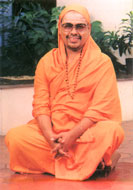Verse 4
patanthu sastrani yajanthu devan, kurvantu
karmaṇi bhajantu devataḥ |
atmaikyabodhena vina vimuktih, na sidhyati brahmasatantare’pi
||6||
Let people study the scriptures;
let Devas be invoked through Vedic rituals; let them do altruistic activities,
let personal gods be propitiated---yet, without the realization of one‘s
identity with the Athma, there shall be no liberation for the individual, not
even in the life times of a hundred Brahmas put together.
After talking about the
glory of human birth, Sri Sankara now starts discussing the means
of Moksha. For attaining Moksha,
there is only one means i.e. gaining and imbibing Self-knowledge. All other
means, study of scriptures, performance of Vedic rituals, sincere worship of
Ishta Devata, altruistic activities, though good and dharmic by themselves
earning Punyam for the performer cannot give one Moksha however long he tries
with devotion. As the reason for one’s feeling of bondage is Self-ignorance and consequent Self-misapprehension, all the noble deeds like yajnas, charity and upasana cannot
remove it. Only Self-knowledge can
remove Self-ignorance as light alone can remove darkness. Self-knowledge is here described as ‘atmaikyabodha’
i.e. knowledge of non-duality of Athma, the Self, i.e. “There is only one
Absolute Reality which is Athma”
Verse
5
chittasya suddhaye karma, na tu vastupalabdhaye
|
vastusiddhirvicharena, na kinchit karmakotibhih ||11||
Actions help to purify
the mind but they do not, by themselves, contribute to the attainment of
Reality. The attainment of Reality is brought about only by Self-Inquiry
and not in the least by even ten million acts.
This verse clearly defines the role of action in the pursuit of Self-knowledge. Actions stand for karma yoga actions like various yajnas, upasana yoga actions like meditation, and bhakthi yoga actions like prayer, bhajans. They help in purification of mind and making it single-minded, to pursue the knowledge but they cannot by themselves, individually and/or collectively give knowledge of Brahman, the Absolute, called here Reality. The knowledge of Brahman is gained by enquiry alone i.e. vasthu-siddhi-vicharena. Vasthu here denotes Brahman, the Reality. So the path to Self-enquiry is through the enquiry into sastras. The enquiry into the sastras is to be done under the guidance of a guru, which will be discussed in the next verse.
Verse 6
ato vicharah kartavyah, jijnasoratmavastunah |
samasadya dayasindhum, gurum brahmaviduttamam ||15||
Therefore, a true
seeker of the Self should proceed with his inquiry after duly approaching a
Master who is established in the experience of the Self and who is an ocean of
compassion.
In this verse Sri Sankara makes an important note that no
one should conduct the scriptural enquiry by oneself as it may lead to
misunderstanding of the scriptures. When the
scriptures are studied from a guru then alone it will be effective for it
will be then converted into liberating knowledge. Otherwise, it will end up in
scholarship only. So he should approach
a guru who is stotriya and Brahmanishta i.e. who is well-versed
in the sastras and is himself established in Brahman. When such a guru is approached
with sraddah and devotion, he will teach, not for money or fame, but out
of compassion to help the jijnasu disciple to achieve his goal of
Self-liberation.
Verse 7
adhikarinamasaste, phalasiddhirvisesatah |
upaya desakaladyah, santyasmin sahakarinah ||14||
Ultimate success in
spiritual endeavours depends chiefly upon the qualifications of the seeker.
Auxiliary conveniences such as time and place all have a place indeed, but they
are essentially secondary.
In this verse Sri Sankara points out that if a student has to benefit from the teaching of a guru not only the guru is fully qualified but the student must also have a prepared mind and intellect, to absorb the teaching. It is like sowing the seed. The seed will be able to sprout and bear fruit in a well prepared soil only. As the knowledge has to take place in the mind, the mind has to be ripe and ready to receive the teaching. Time, place, service to the teacher and so on are no doubt important but they are only secondary and supportive factors that are only indirectly helpful. Adhikari refers to a properly qualified, fit person.
Verse 8
sadhananyatra chatvari, kathithani manishibhih|
ayesu satsveva sannishṭa, yadhabhave na
sidhyati ||18||
Great sages have spoken
of four qualifications for attainment which, when present, (a sadhaka) succeeds
in the realization of Brahman and in the absence of which (the four
qualifications) the realization is not attained.
The
four qualifications, Sri Sankara talks about are the primary qualifications one
needs for engaging in Self-inquiry; desakaladyah, time and place of
enquiry he talked about in the previous verse being only supportive or
secondary factors. These four
qualifications will be listed in the next verse.
Verse 9
adau nityanityavasthu-vivekah pariganyate |
ihamutraphalabhoga-viragastadanantaram ||
samadisatkasampattih, mumuksutvamiti sphutam ||19||
(While enumerating the qualifications), first we count the ability to discriminate between the Real and the unreal; next comes a spirit of detachment from the enjoyment of the fruits of actions here and hereafter; after that is the groups of six virtues beginning with mind control; and the last is undoubtedly an intense desire for liberation.
The four essential qualifications are stated briefly. They will be described in detail in ensuing
verses:
1) Viveka – Discrimination.
The discriminative understanding with reference to what is nitya,
eternal or permanent, and anitya, time-bound or impermanent.
2) Vairagya – Dispassion or detachment. Dispassion towards the anitya vasthu-the objects and pleasures of
this world and the other world as well.
3) Six virtues – The six virtues starting from Sama,
discipline of the mind. These will be enumerated later.
4) Mumukshutva – the burning desire for Moksha
Swami
Paramarthananda sums them up briefly as 4Ds; Discrimination, Dispassion, Discipline
and Desire.
---------------------







